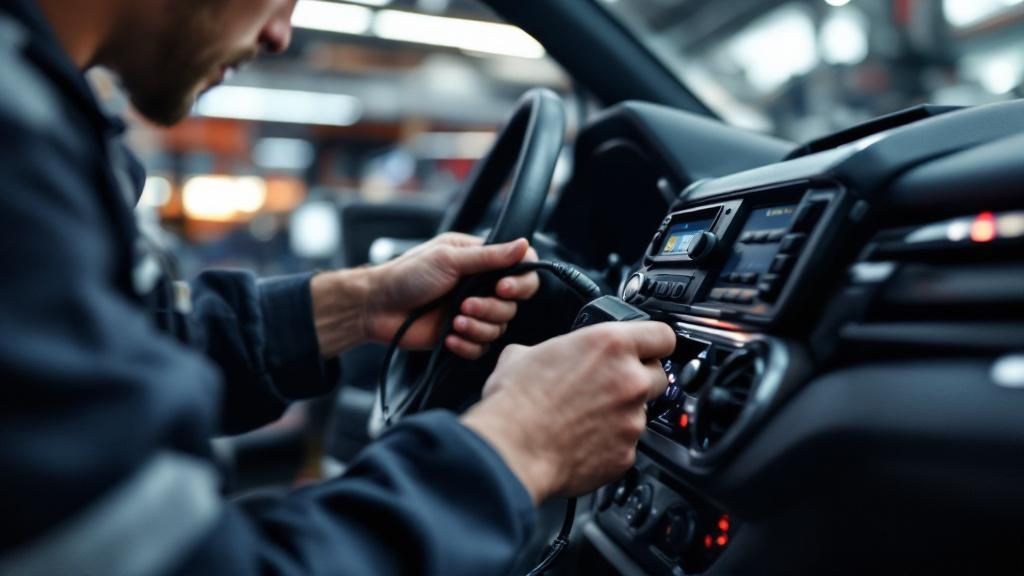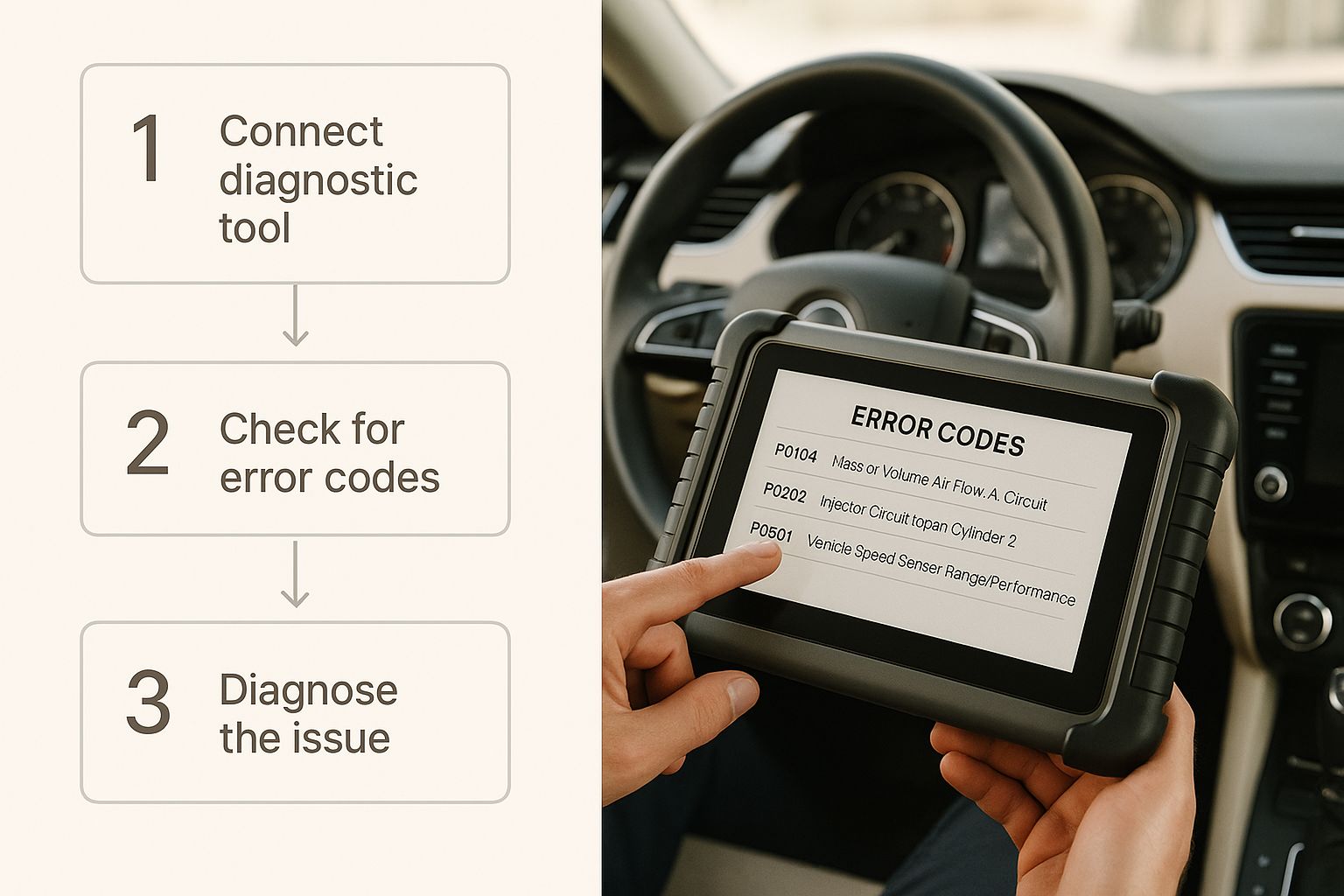Your Guide to a Car Computer Check
- The Gearbox Auto Services
- Jul 1
- 11 min read
That little glowing check engine light on your dash is more than just an annoyance. It's your car trying to tell you something, but it doesn't speak. Think of a car computer check as the universal translator that turns that warning light into information you can actually use. At The Gearbox, we specialize in performing these checks to find out if you're dealing with something as simple as a loose gas cap or a more serious engine problem.
What a Car Computer Check Reveals About Your Vehicle

Here in the UAE, keeping your car in top shape isn't just a good idea—it's essential for safety and performance. A diagnostic check is your best bet for catching small issues before they snowball into expensive, time-consuming repairs. It’s simply smart car care, and it’s a core part of the service we provide for all makes and models.
It's no surprise that the market for these tools is booming. The automotive diagnostic market in the Middle East & Africa was already worth around USD 0.7 billion in 2023. It’s projected to grow by about 5.0% every year for the next ten years, which just goes to show how vital this technology has become in modern vehicle maintenance.
Decoding Your Car's Health
So, what exactly happens during a computer check at our workshop? We plug an advanced On-Board Diagnostics (OBD2) scanner into your car's port, which taps directly into its main computer, often called the Engine Control Unit (ECU). This gives our technicians access to a list of Diagnostic Trouble Codes, or DTCs. Each code is a clue pointing us in the right direction.
For instance, a code might pop up for a faulty oxygen sensor. A basic scan will tell you that, but our professional diagnosis goes much deeper. Our job is to figure out why that sensor is failing. Is the part itself bad? Is there a problem with the wiring? Or is another system causing a chain reaction that trips the sensor code?
A diagnostic code is a starting point, not a final diagnosis. True expertise lies in interpreting that code within the context of the vehicle's overall performance to find the root cause. This is the standard of care we provide at The Gearbox.
Knowing what’s going on under the hood isn't just for fixing problems. It's also a critical part of passing mandatory inspections at vehicle inspection centers like Tasjeel Sharjah. A clean bill of health from a computer check is often necessary to prove your car is roadworthy. At The Gearbox, we make sure your vehicle isn't just running well, but is also fully prepared to meet these strict local standards.
Choosing the Right OBD2 Scanner for Your Car
While you can perform your own car computer check, understanding the tools is key. The first thing you'll need is an On-Board Diagnostics (OBD2) scanner. The market is flooded with options, so let's break down the difference between DIY tools and the professional equipment we use.
The most straightforward choice for a DIYer is a handheld code reader. These are typically inexpensive, no-fuss devices that you plug right into your car’s OBD2 port. They’ll display any fault codes and let you perform a quick, basic check. For simple "check engine" light mysteries, they can be helpful.
Beyond Basic Code Readers
If you want to see more than just a code, a Bluetooth OBD2 scanner is a step up, connecting to an app on your smartphone. It can show you not just codes but also live data streams like engine RPM and coolant temperature, giving you a richer picture of what's happening under the hood in real-time.
But here’s the reality: while these DIY tools are great for getting an initial read, they have their limits. When you're dealing with the complex electronics in modern cars, especially premium European or American models, a basic scanner often just scratches the surface.
At The Gearbox, we rely on advanced diagnostic computers from industry leaders like Bosch and Autel. This professional-grade equipment lets our technicians tap into manufacturer-specific codes and run deep-level tests that consumer scanners simply can't perform. It’s how we pinpoint the root cause of an issue with certainty on brands ranging from Toyota to Porsche.
Our systems can see far beyond generic trouble codes. We're talking about diagnosing complex problems within the transmission, airbags, and ABS—systems a standard reader might not even be able to access.
For a closer look at the differences between what you can buy online and the equipment professionals use, check out our guide to car diagnostic tools in Dubai. It’s the key to a precise and reliable car computer check every single time.
How to Perform a Vehicle Diagnostic Scan
Alright, so you've got a scanner in hand. The good news is that checking your car's computer is much easier than you might think. It’s less about being a master mechanic and more about knowing the right, simple steps to get a picture of what your car's brain—the On-Board Diagnostics (OBD-II) system—is trying to tell you.
First, find the car's OBD-II port. In just about every car made since 1996, this 16-pin connector is hiding under the dashboard on the driver's side. Before you plug anything in, make sure your car is turned completely off.
Pulling the Trouble Codes
Once your scanner is plugged in securely, pop the key in the ignition and turn it to the "On" position. And this part is important: do not start the engine. You want the car’s electronics awake so the scanner can talk to the computer, but you don't want the engine running and creating extra "noise."
Your scanner will power on and start its handshake with the car's computer. Follow the prompts on the screen to get the scan started. In a minute or two, it will pull up any Diagnostic Trouble Codes (DTCs) logged in the system's memory. This is the first step in the same process our technicians use every day.

This image captures that crucial moment of diagnosis. The tool is displaying the specific fault codes that point a technician—or you—in the right direction.
A Quick Tip from Experience: Don't panic if a whole list of codes appears. It's common for a single root issue, like a faulty sensor, to set off a chain reaction of error messages in related systems. The real skill, which our team at The Gearbox has perfected, is figuring out which code is the primary culprit.
While a personal scanner is fantastic for getting these initial codes, remember that a code itself isn't a complete diagnosis. It's a clue. For tricky problems or when you just want a definitive answer, our professional vehicle scanning and diagnostics service can get to the bottom of it with dealership-level accuracy.
Making Sense of Diagnostic Fault Codes
Once the scanner finishes its work, you'll likely be looking at a list of what are called Diagnostic Trouble Codes, or DTCs. Seeing something like 'P0420' might look like gibberish, but this code is your first real clue. The trick isn't just pulling the code—it's understanding what it's trying to tell you, which is where our expertise comes in.
Every code has a specific structure, and the very first letter is your biggest hint. It points you to the main system in the car that's logged a problem. Getting a handle on these prefixes is the first step to turning that cryptic output into useful information.
Breaking Down the Code Prefixes
To make things simpler, you can think of the code prefixes as broad categories that immediately narrow down your search.
Here's a quick look at what each letter means:
P is for Powertrain: This is the big one, covering the engine, transmission, and all related emissions components. A P0301 code, for example, is a classic sign of an engine misfire in the first cylinder.
B is for Body: These codes deal with components inside the passenger cabin. Think climate control, interior lighting, power seats, and airbags. Seeing a B0028 code often points to a problem with a side airbag sensor.
C is for Chassis: This category includes systems outside the passenger compartment, like the steering, suspension, and, critically, the brakes and ABS. A code like C0221 might signal a fault with the front right ABS wheel speed sensor.
U is for Network: Modern cars are rolling networks. U-codes indicate a communication breakdown between the various computer modules. A U0100 code, for instance, means the main engine computer has lost communication with another module.
A quick way to reference these is with a simple table. It's a handy guide for getting your bearings when you first see a code.
Common OBD2 Fault Code Prefixes
Code Prefix | System Category | Common Examples |
|---|---|---|
P | Powertrain | (Random Misfire), (Catalyst System Efficiency Below Threshold) |
B | Body | (Seatbelt Pretensioner Fault), (Heater Control Circuit Malfunction) |
C | Chassis | (ABS Wheel Speed Sensor Fault), (Steering Angle Sensor Circuit Failure) |
U | Network | (Lost Communication with ECM/PCM), (Lost Communication with ABS Module) |
Having this table nearby can quickly demystify what your scanner is telling you, pointing you in the right direction from the very start.
Keep in mind that a single fault can sometimes set off a chain reaction, triggering codes in different systems. We see it all the time at The Gearbox—a failing alternator (a Powertrain issue) can cause low voltage, which then leads to a series of Network communication errors (U-codes). An experienced technician knows to look past the U-codes and trace the problem back to the alternator, which is the root cause.
This reliance on diagnostics has grown incredibly fast. Here in the UAE, around 70% of vehicle repairs now begin with a computerized scan. That's a huge leap from less than 50% just a decade ago. This trend highlights why a proper car computer check is no longer optional—it’s essential for modern car care. You can discover more insights about the automotive diagnostics market to see just how much this technology is changing vehicle service.
At The Gearbox, we use this exact technology to pinpoint the real problem, saving you the headache and expense of just guessing and replacing parts.
Common Mistakes to Avoid During a DIY Check

Jumping into a DIY car computer check can feel like a big win, but a few common missteps can quickly turn a simple task into a frustrating ordeal. At our workshop, we often see the results of this: a car owner gets a trouble code and immediately rushes out to buy the part it points to. This is, without a doubt, the biggest pitfall.
More often than not, this leads to wasted money and a car that still isn't fixed.
Another classic error is clearing the code and just hoping for the best. The code is a symptom, and simply erasing it won't fix the underlying problem. That check engine light will be back. Even with a good scanner, you have to be mindful of potential pitfalls, including the common mistakes when using a digital defect reporting tool, to get an accurate picture.
Use Codes as Clues, Not Conclusions
Treat the information from your OBD scanner as the starting point of your investigation, not the final word. A perfect real-world example is the infamous P0420 code, which points to low catalyst efficiency. The knee-jerk reaction is to assume you need a pricey new catalytic converter.
But hold on. The actual culprit could be something much simpler and cheaper, like:
A faulty oxygen sensor
An exhaust leak somewhere in the system
An engine misfire that's dumping unburnt fuel into the exhaust
A Diagnostic Trouble Code points you to the "scene of the crime," but it doesn't name the culprit. Proper diagnosis involves testing components and looking at the whole system to find the root cause, which is a key part of our service philosophy at The Gearbox.
Ignoring this basic principle is what separates a successful DIY fix from an expensive guessing game. Use the code to guide your next steps. If you have an exhaust-related code, start by visually inspecting for leaks or checking live data before condemning a major component. This is the same methodical approach our technicians take.
For a deeper dive on what to look for, our guide on car routine maintenance tips for car exhaust system repairs can be a big help. This methodical approach is what truly empowers you as a DIYer.
Why Our Professional Diagnostic Service Is Different
When a simple OBD scanner hits its limit, that's where we come in. A generic code reader might point you in the right direction, but our professional car computer check tells the full story—something that's absolutely critical for the complex cars we work on daily, from high-tech German engineering to rock-solid Japanese and American models.
We don't just pull a code and call it a day. Our certified technicians in the UAE use advanced, manufacturer-level diagnostic tools from brands like Bosch and Autel that cheap handheld scanners simply can't compete with. This lets us dig much, much deeper.
Beyond Generic Code Reading
We treat diagnostics like a proper investigation. Getting it right the first time is our priority, saving you the headache and expense of swapping out parts that weren't the problem to begin with. Here’s what our comprehensive service at The Gearbox offers:
Analyzing Live Data Streams: We tap into the real-time data flowing from your car's sensors. This means we can watch everything from engine performance metrics to transmission behavior as it happens, spotting subtle issues a static fault code would completely miss.
Checking System Readiness Monitors: Before starting any major work, we confirm that all your vehicle’s emissions systems are online and have run their self-checks. This is a must-do to ensure you’ll pass the mandatory vehicle inspections here in the UAE.
Performing Functional Tests: Our equipment doesn't just listen; it talks back. We can command specific parts, like a fuel injector or a cooling fan, to turn on or off. This lets us test components directly, confirming if a part has truly failed or if the problem is hiding somewhere else in the system.
At The Gearbox, we know a fault code is just a symptom, not the disease. Our technicians use their experience to interpret these clues, hunt down the root cause, and break the expensive cycle of guesswork and repeat repairs.
This isn't just our philosophy; it's where the entire industry is headed. Across the UAE, in-depth computer checks are becoming a standard part of vehicle maintenance. Our advanced OBD systems are key to this, letting us translate raw data from your car's computer to find engine and emission problems fast. For a deeper look at this trend, you can discover more insights about the automotive diagnostics tool market.
Frequently Asked Questions About Car Computer Checks
Got questions? We get it. Diving into your car's computer system can feel a bit technical, but a little knowledge goes a long way. Let's walk through some of the most common questions our technicians at The Gearbox hear on a daily basis.
We're big believers in transparency. An informed driver is an empowered one, and that’s why we’re always open about our process and the tools we trust from brands like Bosch and Autel.
How Often Do I Need a Car Computer Check?
The most obvious time is whenever a warning light pops up on your dash—especially that dreaded check engine light. But don't wait for trouble to find you.
We strongly recommend a full diagnostic scan as part of your annual service. Think of it as a health checkup for your car. This proactive step can help us catch small issues with the engine, transmission, or even the AC before they snowball into expensive repairs, which is why it's a key part of our service packages.
Does a Scan Work on My Luxury Car?
Yes, but this is where our professional service makes all the difference. A basic, off-the-shelf scanner might pull generic codes from any modern car. However, high-end vehicles from brands like BMW, Mercedes-Benz, Audi, and Porsche have incredibly sophisticated electronics.
These cars log hundreds of manufacturer-specific codes that a standard tool won't even see, let alone understand.
That’s why our service is key. At The Gearbox, we use specialized, dealership-grade equipment that communicates directly with your luxury car's brain. This lets us access the deep, proprietary data needed for a truly accurate and comprehensive diagnosis—something you just can't get otherwise.
Can Clearing a Code Fix My Car?
This is a big one: No. Clearing a Diagnostic Trouble Code simply erases it from the computer's memory and turns off the warning light. That’s it.
It's like hitting the snooze button on an alarm clock. You've silenced the warning, but you haven't solved the reason it went off in the first place. The mechanical or electrical fault is still there, and you can be sure the light will come back on eventually. The only permanent fix is to properly repair the underlying problem identified by an accurate computer check from a professional service like ours.
At The Gearbox Auto Services, we deliver a dealership-level experience without that dealership price tag. Our expert mechanics use the same modern, high-tech equipment from leading brands like Bosch and Autel to give your vehicle the precise care it deserves. For a truly reliable car computer check and all your service needs, check us out at https://www.thegearbox.ae.

Comments